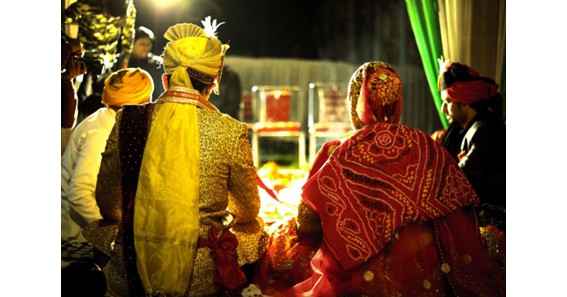The lively and colourful culture of Punjab is reflected in the wealth of traditions and practices that make up Punjabi marriage. Every stage of the wedding process, from pre-wedding customs through the actual ceremony, is marked by happiness, celebration, and family reunion. This will provide you helpful insights into the lovely and significant traditions that go along with the sacred tie of marriage in Punjab, whether you are planning a Punjabi wedding or are just curious about this interesting culture.
Pre-Wedding Rituals:
1. Roka:
The Roka ceremony, when the family of the bride and groom formally approve the relationship, is the first stage of a Punjabi matrimony. It involves exchanging gifts, blessings, and the announcement of the forthcoming wedding.
2. Chunni Chadai:
The groom’s family presents the bride with a colourful scarf called the Chunni, which she wears over her head to symbolise acceptance into the groom’s family.
3. Sagan:
The Sagan ceremony involves the exchange of gifts and blessings between both families. It is typically held at the bride’s house and signifies the formal acceptance of the groom into the bride’s family.
Click Here – What Is Lord Hanuman Height?
4. Mehndi:
The bride’s hands and feet are decorated with exquisite henna patterns during the festive Mehndi ritual. It is accompanied by singing, dancing, and celebratory music.
Wedding Day Traditions :
1. Vatna:
As part of the Vatna ritual, the bride and groom’s bodies are covered in a paste made of turmeric, sandalwood, and mustard oil the morning of the wedding. This is thought to provide the pair a dazzling glow and good fortune.
2. Ghodi Chadna:
The groom arrives at the wedding venue on a decorated horse or Ghodi, accompanied by a lively Baraat (wedding procession). The groom’s family and friends dance and celebrate as they make their way to the wedding venue.
3. Milni:
The Milni ceremony is a formal introduction between the two families. The male members from both sides exchange garlands, hug, and shower each other with blessings and well wishes.
4. Pheras and Laavan:
The couple takes four pheras (circumambulations) around a sacred fire, symbolising their mutual promises and commitment to each other. The Sikh wedding ceremony concludes with the recitation of the Laavan, hymns that describe the stages of a fulfilling married life.
Post-Wedding Traditions:
1. Doli:
The Doli ceremony marks the departure of the bride from her parental home. She is bid farewell by her family amidst tearful and joyous emotions. The bride’s brothers play a significant role in carrying the Doli.
2. Reception:
A magnificent celebration is held after the wedding ceremony so that family, friends, and well-wishers can congratulate the newlyweds. It entails fun activities like singing, dancing, eating, and enjoyment.
3. Vidaai:
When the bride formally departs from her family house to begin a new life with her husband, it is a touching event known as the Vidaai.It is a heartbreaking goodbye as she leaves her family and moves to her new residence.
Royal families bring an added level of prestige and cultural significance to the wedding ceremony. Their involvement ensures the adherence to traditional customs, the inclusion of regal elements, and the preservation of heritage. Royal matrimony is a matrimonial site which embodies the essence of Punjabi culture, showcasing opulent decorations, exquisite attire, and elaborate rituals. It symbolizes the deep-rooted connection between tradition, royalty, and the celebration of love, making Punjabi weddings truly majestic and unforgettable.

